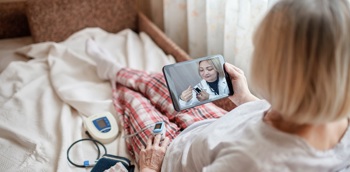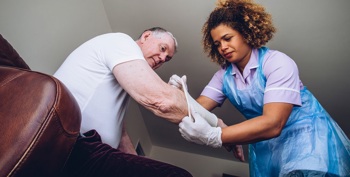
Virtual Ward case studies
Below are links to the 10 case studies from NHS trusts and other organisations from which we present findings as testimony, to show the impact of virtual wards on the NHS’ ability to provide care. For ease, we will refer to these as Case Study 1, Case Study 2 etc.
- An Economic Evaluation of a virtual Covid Ward in Leicester, Leicestershire, and Rutland
- An Economic Assessment of the South Eastern Trust Virtual Ward (Ulster and Bangor)
- Rapid Evaluation of the Virtual Ward at Croydon NHS
- Review of Gateshead virtual ward
- The virtual diabetes hospital
- Virtual Wards: First-of-kind case study on heart failure
- South Devon & Torbay CCG Virtual Wards
- Hospital at Home is a good option for older people
- Virtual Ward case study for Mersey Care magazine
- East Sussex Heart Failure Patients Endorse Virtual Wards Trial
Virtual ward ROI
For virtual wards to be rolled out nationally they need to be demonstrably a benefit both in terms of care provision but also financially. Care can always be improved by throwing money at it, but the challenge is making improvements in a cost-effective manner, allowing for spending in other areas of healthcare – research and development, maintenance, or additional staff are just three examples.
Case Study 1: Virtual Covid Ward in Leicester, Leicestershire, and Rutland
This study was performed during 2020/21 at the height of Covid-19. The report praised the reduced hospital admissions, which were in turn reducing the risk of hospital-acquired infections or other illnesses.
In the article’s own words, “The cost of treating a healthcare associated infection varies, but the Department’s productivity calculator estimates that each avoidable healthcare associated infection costs the NHS £4,300.”
The total benefit of the virtual ward period assessed was 1,103 bed days saved, equating to £529,719 in net financial savings. As this was a Covid ward it was used for those on oxygen and those being weaned off. The mean cost of intervention (placing a patient on a virtual ward) was £184.38 per patient. The cost for traditional hospital care would be £193.40, making it 9.7% cheaper this way than through standard admission, but this is just for treatment. According to University Hospitals Leicester, a bed day in November 2020 cost £532. This makes the £184.38 just 34.7% of the cost.
The 30-day readmission rate was just 2.9%, and £1,709 was estimated saved – not including readmission costs – per patient through this virtual covid ward.
Case Study 2: South Eastern Trust virtual ward in Northern Ireland
This case study from the South Eastern Trust, covering Ulster and Bangor in Northern Ireland, was a very helpful assessment as it provided financial estimates for the cost of setting up a virtual ward. The report states a figure of £32,974 needed to establish the virtual ward for patients with chronic conditions.
Running costs are also accounted for, at an annual rate of £188,757.66 per year to run a virtual ward. This is derived from the three-year trial period for this virtual ward which reported running costs were £566,273 total.
It’s important to know the costs and not just the savings, but the good news is that the savings far outweigh the costs so far. Additional figures included 4,547 hospital bed days saved (based on average stay), at a rate of £350 per day bed costs - based on KPMG cost analysis (2014/15) and adjusted with 2.5% inflation. These savings totted up over the three-year trial period for the virtual ward added up to a gigantic £8,804,529. Minus the running costs the total three-year saving was £8,238,256, or £2,746,085.34 per year saved.
The only concern is the inability to assess social care input. For South Eastern, this was help from Allied Health Professionals. A figure of £5,278 per year was generated based on 6 hours of physiotherapy per month, but this was data not collected by the virtual ward itself. Furthermore, the report itself states “There are occasions where to maintain a patient at home, a Social Care Domiciliary Care package requires to be commenced or increased. As this does not occur in all occasions, it is extremely difficult to cost.”
Case Study 3: Rapid Evaluation of the Virtual Ward at Croydon NHS
Return on Investment and other financial figures get less apparent in other available case studies at present. Croydon NHS reported an estimated saving per patient, thanks to a shift to phone calls or video calls, of £742.44. This is broken down to £522.12 on hospital treatment and £220.32 on bed requirement and was tested against a rapid response control group for patient care.
Case Study 4: Review of Gateshead virtual ward
Like Croydon, Gateshead was very minimal on ROI, but also very vague. The review of Gateshead virtual ward estimated ‘cost avoidance’ over a year period. The savings ranged from £405 to £6,610, but there’s little explanation as to what savings were made or how they were made unfortunately.
Case Study 5: The virtual diabetes hospital
Hull & East Yorkshire Hospitals NHS Trust run a virtual diabetes hospital to help avoid institutionalisation of patients who are vulnerable. The approach keeps patients more relaxed and comfortable and reduces the average length of an inpatient stay by three days – saving £400 or more per admission.
The initial cost of implementing a virtual ward can be off-putting, given it’s a lump sum required to start up the new ward programme, but the return on investment is not only evident it’s clearly a huge advantage in the longer term. The return on investment is too good to miss out on, but thankfully there are funds – such as the Service Development Fund - that can help with the initial setup. More information can be read in our Virtual Wards Funding and Costs article.

Virtual ward patient outcomes
Now we know fair estimates for how much a virtual ward costs to set up and to operate, we move on to the patient outcomes: how good are virtual wards for patients?
Case Study 1: Virtual Covid Ward in Leicester, Leicestershire, and Rutland
The Leicestershire case study shows 812 hospital admissions avoided over the three-year assessment period of their Covid virtual ward, with 447 episodes of care provided by the virtual ward.
Accident and Emergency attendance was monitored for the purpose of this, with a 60% reduction in attendance, though it should be qualified that this was a Covid ward, and the government advice was to avoid going to hospital unless in dire need. This may impact the results unfairly.
Patient testimony is important though. The report cites Mrs X, who had a respiratory disease which resulted in regular A&E attendance and admission to hospital wards. The document states: “Mrs X, her daughter, and her GP all positively evaluated the virtual ward service, and all felt that without the service input her pattern of frequent admissions would have continued.”
Case Study 3: Rapid Evaluation of the Virtual Ward at Croydon NHS
Croydon NHS helpfully broke down its patient outcomes into bullet points. 250 patients were monitored via their virtual ward.
- 65% (162 patients) received entirely home monitoring and support
- 20% (50 patients) were admitted to hospital whilst on the virtual ward
- 84% of these were discharged home
- 10% realised that telehealth was not appropriate and were discharged early and referred on to more appropriate services for their needs
- 4% of patients declined the monitoring devices or asked for them to be removed
- 1% of patients died during their time on the virtual ward
- 12% of patients were re-admitted post-discharge
- 9% of patients were admitted to hospital directly post-discharge
These figures will serve as a valuable control set of data for other virtual ward trials across the UK, but the ultimate outcome was that telehealth monitoring (home hubs, wearable devices) enabled much quicker detection of illness or deterioration and allowed more proactive care for better treatment results. Croydon specifically refer to 10 patients; five with pulmonary embolism, two with heart arrhythmias, two with sleep apnoea, and one with persistent tachycardia. All are dangerous conditions, but the virtual ward caught these dangers successfully.
Case Study 4: Review of Gateshead virtual ward
The Gateshead review was again quite limited in its findings, but the healthcare professionals consulted were positive about the impact of the virtual ward. In their anecdotal evidence they praised the reduction in acute care admission, the fact that there were fewer outpatient attendees, and an overall reduction in A&E usage.
Case Study 6: Virtual Wards: First-of-kind case study on heart failure
West Hertfordshire Teaching Hospitals NHS Trust operate a Heart Failure Virtual Hospital. This is a specialist virtual ward, designed to prevent readmission. The trust’s statistics show an 11% reduction in the readmission rate for acute care. This is based on 3.6% standard readmission rate for those in hospital care, versus 3.2% for those in the virtual ward. Similarly, virtual ward patients outperformed non-virtual ward patients. 15.5% of hospital patients were readmitted, compared with just 9.6% when on virtual wards – a 38% reduction.
Case Study 7: South Devon & Torbay CCG Virtual Wards
South Devon and Torbay also lacked explicit statistics, though they did list out their patient outcomes. The report citing improved inter-service communication, improved coordination with carers (including support for carers), and a greater focus on compliance. The most welcome improvement was greater consultation with patients and carers, with an emphasis on regular communication, keeping the patient informed, and better acknowledgement of patient wishes – especially at end of life.

Virtual wards patient satisfaction
The final criteria for virtual ward impact is patient satisfaction; how satisfied were patients (and their families) with the care provided? Was it an improvement? Did they feel adequately supported?
Case Study 1: Virtual Covid Ward in Leicester, Leicestershire, and Rutland
The Leicestershire study had a 70% response rate to the patient satisfaction survey, but 100% of those who answered were ‘very satisfied’ with the care quality – an incredible achievement.
On top of this, 85% felt more confident managing their own condition as a result of the virtual ward care. Action was taken to improve patient education regarding their conditions, which was also incorporated into the treatment plan. This greater collaboration in the individual’s care process meant patients were much more understanding of warning signs, which led to quicker action from the virtual ward staff to tackle any deterioration in condition or new symptoms.
Case Study 3: Rapid Evaluation of the Virtual Ward at Croydon NHS
Croydon NHS also saw strong feedback from its patient survey. 87% of patients felt the virtual ward care had been a positive experience. Particular praise was given to the ease of using the home monitoring kit (89% positive) and the ease of using the devices to report back to clinicians.
The report said that “Patient interviews indicated that there had been a significant improvement to patients’ quality of life since being cared for under the virtual ward team.”
Case Study 6: Virtual Wards: First-of-kind case study on heart failure
West Hertfordshire Teaching Hospitals NHS Trust was very short and sweet with its patient satisfaction figures. To quote the report directly:
- “83% of patients agreed that going home sooner from hospital aided their recovery”
- “85% of patients agreed that they felt safe as a patient in the Virtual Hospital”
- “88% of patients agreed that the frequency of contact and communication by the monitoring hub was about right.”
Case Study 8: Hospital at Home is a good option for older people
The National Institute for Health and Care Research (NIHR) reported specifically on older patients and their impressions of virtual wards – in this case referred to as Hospital at Home. General feedback was that patients were satisfied with the service and that recovery at home was better equipped than a hospital, especially when considering bathroom needs for example.
There was a disparity between home care and sheltered accommodation though, with the deliberate independence of the latter being notably less suited to virtual ward care. Patients reported issues without handrails to assist mobility, a lack of space for a domiciliary care worker to stay overnight, and a lack of warden contact in case of emergency.
This isn’t explicitly the fault of virtual wards, but the virtual ward scheme has to factor in the bigger picture of patient wellbeing and safety.
Case Study 9: Virtual Ward case study for Mersey Care magazine
Mersey Care magazine, as shown here by healthcare solutions provider Docobo, ran a case study feature around Colette Melia and her experience with Crohn’s Disease. Her testimony speaks about the home kit (blood pressure monitor, oximeter etc) and the training about how to use these home monitoring devices.
Colette’s experience was initially one of apprehension, but with the ease of use came confidence, and with the speed of response from clinicians came reassurance that virtual ward care was not going to be a gimmick.
In her own words: “It’s perfect. You know they’re there, watching your readings, which gives you the confidence to get on with your life. I was so worried before, I couldn’t concentrate on anything. I feel like I’ve got my life back.”
Case Study 10: East Sussex Heart Failure Patients Endorse Virtual Wards Trial
Like Case Study 1, the people surveyed by East Sussex virtual ward trial confirmed 100% satisfaction with the virtual ward experience; before, during, and at discharge.
One patient quote given to the Sussex ICS said: “It was a really good experience and has kept my husband out of hospital and that has made his recovery far quicker, he hates hospital with a passion! It has been efficient and the critical care team have been outstanding. I believe this will benefit other people greatly in the future.”
The conclusion from all of the patient testimony is that it’s incredibly important for patients to be comfortable. Generally speaking, they are more comfortable at home. They prefer it to the hospital, they can see family, have their own food, their own comforts. If a patient can be cared for from home, then we should be striving to do that, because their mental resilience is demonstrably boosting their recovery. This is good for the patient, and good for the NHS which needs to look after money in every way possible and get the most care out of a finite budget.

NHS outcomes framework virtual wards
NHS Outcomes Framework (NHS OF) is a measurement of performance and success within the NHS, which is reported back to the Secretary of State for Health to monitor progress.
The function is to ensure accountability by delivering transparency around facts and figures – many of the like we have used in this article. Through this transparency, healthcare professionals and NHS management can assess the good and the bad and plan to improve care quality; setting targets for the short or long term in the process.
The NHS Outcomes Framework 2022 publication exists in the public domain but, due to the merger of NHS Digital and NHS England, the 2023 report has been delayed from its annual March release. As such, new figures about the rollout of virtual ward are currently unavailable, which in turn delays the bigger picture contrast of statistics regarding mortality and disease.
Check out our virtual wards software and see how our unique eco-system can help deliver a virtual wards future
NHSE Virtual Wards Operational Framework
After an evaluation of the South East that saw the region make over £10 million in annual savings from virtual wards, NHS England (NHSE) published a newly updated operational framework in September 2024 to coincide with the expansion of virtual wards across the UK.
The guidelines have been designed to support health providers in meeting the objectives outlined in the NHS 2024/25 Urgent and Emergency Care Recovery Plan with the following requirements:
- Robust governance and clinical leadership, overseen by a GP, consultant physician, consultant practitioner.
- Operation between the hours of 8am to 8pm, seven days a week, with after-hours support in place.
- Clear admission criteria and assessment protocols.
- Personalised care planning with patient involvement in the decision-making process.
- Senior clinician-led daily ‘board’ rounds, with input from the multidisciplinary team.
- Availability of hospital-grade diagnostic services.
- Delivery of hospital-level treatments and interventions.
- Integration of remote patient monitoring (RPM) and other tech-enabled care solutions.
- Pharmacy services focused on medication reconciliation and optimisation.
- Clear processes for patient discharge and proper monitoring of length of stay.
Download our Virtual Wards guide for more information on how to set up your hospital at home and ensure it complies with the new virtual wards operational framework.

